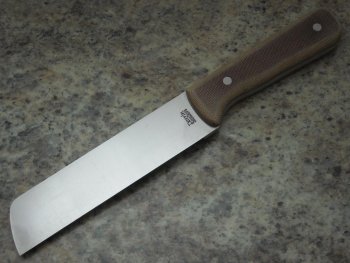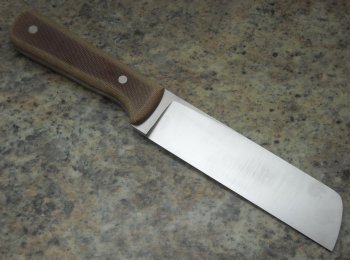With the methodology that I use, I leave the edges as I mentioned before (approx. 3/32" of a flat edge prior to heat treat). On most blades I produce, I've discovered over the years that no matter how shallow or heavy the convex put on the edge, it's helpful to take it to the point to being relatively a sharpened edge during finish grinding. You have to be cautious hand finishing, but once everything is done, a VERY light pass on each side of the edge with a worn out 400 or 600 slack belt is all that needed for a "working edge", and if you want that "scary sharp" edge, a single light pass on a buff with pink no-scratch after the belt(s). The idea being to have the very minimum edge bevel, and to have it convex rather then at a given angle (any angle on a sharpened edge creates cutting resistance, where as a convex edge reduces cutting resistance greatly.)
Probably one of the best experiments I ever did was when I was trying to understand the impact of bevels/geometry on how a blade cuts materials..... put on a high powered set of optivisors, then cut various materials, watching the cutting edge. You'll be blown away at what you discover with how different bevels/angles cut different materials versus using radius and/or convex to cut the same materials. Generally any blade with angles in the geometry will create those "wedges" that I mentioned, where as blades that have smooth radius/convex gemoetry will just "flow" through the material being cut, rather then running into those "wedge" points that cause excessive cutting resistance.
I suspect some would say it really doesn't matter, and that's OK, but in my experience it's the attention to detail that separates one maker's blades from another's. From a customer/client point of view, they may not be able to point directly to why they like one blade over another, but when you have clients saying that a given blade "Cuts great even when it's a bit dull." Or, "This blade just cuts like a laser", it's that experimentation and adjustment on the "little" things that brings about those types of comments, and bolsters your reputation as a knifemaker.

The other side of that is that IF you go that route, you will establish a standard for your blades....which means that the established standard must be met or exceeded with each successive knife you produce. (There's that "give-n-take" thing that I'm always talking about)






